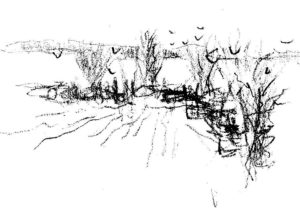Columnists
Shelter belts

Chokecherry, hawthorn, hedge rose and willow. Farmland that was once partitioned into 10-acre plots; bordered with split cedar fences and filled in with rows of trees and shrubs that when seen from on high transform into a hand- stitched quilt spread about the land. The partition of farmland in previous centuries was a working system predicated on the need for protection against wind erosion, for animal grazing and crop rotation between plot to plot to allow pause for the soil, to give rest, to lie fallow.
Within the geometrics of the layout, a central corridor—a lane—ran through, much like a hallway connecting rooms. At milking time a farm worker would open the wooden gate of whichever field livestock were grazing and the herd would follow the pathway that led down to the barn. Lining these corridors were apple and pear and peach trees, to be harvested in season and to provide shelter and food for wildlife throughout the year.
 Ever since this layout was first brought to my attention by a friend, it has stuck in my memory as being a holistic approach, a consciousness of the pacing of the soil to regenerate in order to give back. The surrounding atmosphere was integrated within recognition of our role as only one part of a natural balance.
Ever since this layout was first brought to my attention by a friend, it has stuck in my memory as being a holistic approach, a consciousness of the pacing of the soil to regenerate in order to give back. The surrounding atmosphere was integrated within recognition of our role as only one part of a natural balance.
I often walk the fields where I may. I follow the hedgerows where red osier dogwood, lilac and sea buckthorn grow among the heaps and scatterings of ‘hard heads’, the granite boulders left behind by melting glaciers, unearthed by the steel plough, then loaded onto ‘stone boats’ to be barged and docked amongst the hedgerows. The story remains of men and women, a quiet recounting of lives lived, the sweated brow now demarked among the borders that lie among some fields today; a telling of a life in a way more poignant than the telling of a death inscribed on granite beacons that stand platoon- like in stalwart order, frozen against the far rise of aspen and birch.
The hedgerows are archival in many ways; the layout of former-generation farms is a history written on the land, an account slowly vanishing like a footprint in the sand.
What is not history are the migrating birds; the redpoll, waxwing, junco and chickadee. The cardinals, snow buntings, grosbeaks and finches; the pine siskins, nuthatch and hawk and the eagle. There are the ground feeders: mice and lemmings and hare, groundhog, squirrels and chipmunks that populate these hedgerows as part of a natural cycle. The arriving robin is now in search of worm casings, the flower of the sumac.
I am not a farmer. I am unaware for the most part of the economies of scale of any form of agriculture. I am an observer, a seeker engaged in the rhythm of the seasons. I note, in my travels of now, the triggering of the emotions of loss I feel upon witnessing the brutal mechanical tearing and thrashing in the destruction of the hedgerows in field after field after field, along side roads and back roads. It appears to be a focused trend where wetlands are bulldozed, where forest islands are razed with machines the size of houses, where the refuges of the whiskey Jack, the snowy owl and spruce grouse are decimated.
I speak, not so much with sentiment, but in answer to a chilled voice of mourning that emanates from the fields of destruction here on our island; felt throughout the continent now the songbirds are disappearing. It is as if we have returned to a history that recorded the taming of the savage lands; and of the forest as a dark and daunting enemy; that the image has been revived and a renewed battle is underway.
This morning, through the rain, I watch the smoke rise over the fields to the east, the burn piles of once habitat. I cannot erase the image of the sacrificial pyres that imbued the immoral conquests in ancient and ugly wars.



Comments (0)